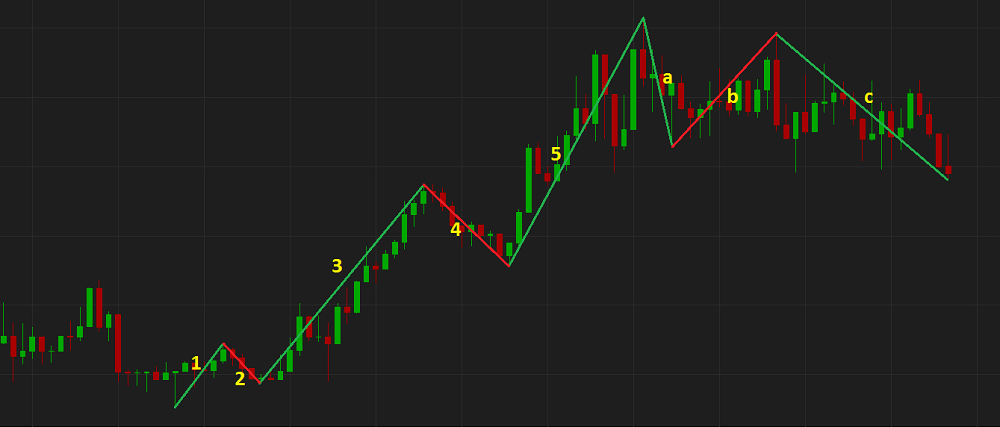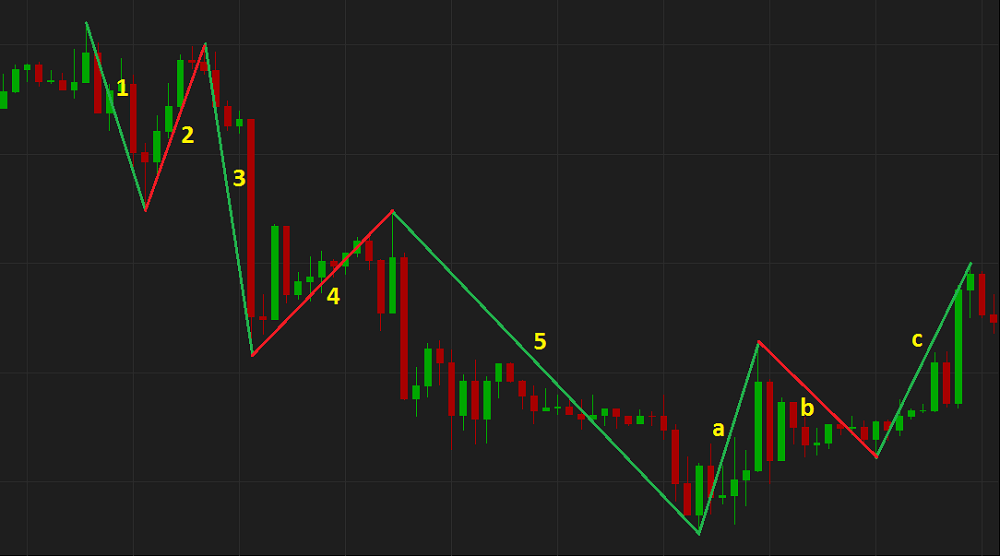
and on a downtrend price chart.

According to Elliott, the 5-wave motive sequence of an Elliott wave pattern must comply with the following three rules:
EWN (Elliott Wave Number)
EWN (Elliott Wave Number) is one of three Waves indicators included in the list of standard indicators of Marketscope (the other two are EW (Elliott Wave Indicator) and EWO (Elliott Wave Oscillator)). The indicators help to apply Elliott Wave Theory to forex trading. The theory itself was developed by Ralph Nelson Elliott (1871-1948) in 1920s - 1930s and covered most comprehensively in his major work Nature's Laws: The Secret of the Universe in 1946.
Elliott Wave Theory asserts that crowd trading behavior ebbs and flows as waves in a sea and makes the market prices move in the same way. Based on this ebb and flow nature of price movements, Elliott identified a certain fundamental wave structure (or pattern) consisting of a 5-wave motive sequence (numbered 1, 2, 3, 4, and 5) followed by a 3-wave corrective sequence (lettered a, b, and c). In fact, Elliott Wave Theory is much more complicated than this 5-3 combination, but in this article, we will mention only the very basics. Motive waves move in the direction of the market trend. In an uptrend, rising waves are called impulse waves, and declining ones are called corrective waves. Conversely, in a downtrend, declining waves are called impulse waves, and rising ones are called corrective waves. The underlying 5-3 pattern remains constant regardless of its time frame. Any impulse wave comprises five motive waves of a smaller time frame, and any corrective wave consists of three corrective waves of a smaller time frame.
On the following pictures you can see examples of Elliott Waves on an uptrend price chart.

and on a downtrend price chart.

According to Elliott, the 5-wave motive sequence of an Elliott wave pattern must comply with the following three rules:
Besides the three rules that must hold true at all the time, Elliott worked out numerous guidelines, but in this article, we will mention only three key ones:
Elliott Wave Theory is very dependent on an accurate wave count. If any of the three rules does not hold true at any moment, a trader needs to begin a new count. Moreover, even with accurate counts, a trader needs to re-evaluate and adjust counts as a new price emerges. Besides, determining where one wave ends and a new one starts is extremely subjective. To offset the reliance on subjective wave counting, EWN (Elliott Wave Number) and other Waves indicators of Marketscope (EW (Elliott Wave Indicator) and EWO (Elliott Wave Oscillator)) have been developed.
Elliott Wave Number is intended to assist in Elliott waves' counting. It is achieved by monitoring of EW and EWO values and assessing whether they meet the requirements at which Elliott waves 3, 4, and 5 can be identified. The values are calculated automatically (some examples of the assessment logic are provided later in the article). On a chart, the results are presented as a horizontal line of an oscillator within the range between 0 and 5. The line assumes only values 3, 4, and 5 as correspond to the Elliott wave that are crucial for formation of an Elliott Wave pattern. Lines 1 and 2 are also important, but at their stage, it is too early to foresee an emergence of an Elliott Wave pattern. The line can shift up and down between values 3, 4, and 5, and only when they line up in a correct order (3, 4, and 5), a trader can assess the formation and decide whether the count is correct for an Elliott Wave pattern or not. Note that the oscillator is good for assessing 5-wave module sequences (numbered 1, 2, 3, 4, and 5) and does not work for 3-wave corrective sequences (lettered a, b, and c).
EWN is always drawn in an additional area below the market price chart.
On the following picture, you can see an example of EWN.

EWN works best in conjunction with the market price chart and other Waves indicators.
Please remember that as its Data Source the indicator uses the historical data and provides the information that belongs to the past. A trader can only suppose that the market situation will continue to develop in the same way for some time in the future and try to use the supposition appropriately.
To apply an EWN to a chart, a trader needs to follow the procedure common to all Marketscope indicators. For more information, see the Add Indicator article.
During the procedure, a trader can customize an indicator by specifying its parameters in the Properties dialog box. For more information, see the Change Indicator Properties article.
The parameters fall into two groups:
EWN has the following Calculation parameters:


The parameters are available on the Parameters tab of the EWN Properties dialog box under the Calculation heading.
When an EWN is drawn on a chart, a trader can use its data in counting Elliott waves. As it is, EWN does not produce any direct trading signals.
The EWN values are calculated automatically using numerous formulas for determining when this or that shift of the oscillator's line takes place. Here are some examples:
EWN =3 if EW = 1 and EWO > 0
EWN switches from 3 to 4 if EW = 1 and EWO = 0
EWN switches from 4 to 5 if EW = 1 and EWO = 0
and so on
where:
EWN - is the EWN value of the period being calculated.
EW - is the EW value of the period being calculated.
EWO - is the EWO value of the period being calculated.